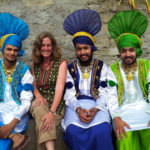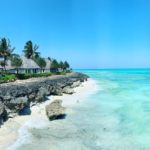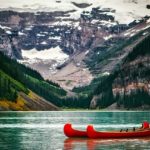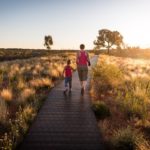Family Adventures in the Amazon

I have a serious case of the travel bug, but I was a wee bit apprehensive about travelling into the depths of the Amazon with my family for five nights. Nevertheless, I felt energized by the excitement of the quest. We flew into Iquitos, the largest metropolis in the Peruvian Amazon, and drove ninety minutes to Nauta, where a riverboat named the Delfin awaited us. My family and I were fortunate to float down the second largest river in the world on an incredible riverboat equipped with the luxuries of a hotel. The idea of being in a secluded and serene setting while venturing into the untamed and natural world gave me an adrenaline rush.
As the Delfin glided down the mirror-like jungle waterways, I was restless and ready to meet the Ribereños, an indigenous community who call the Amazon River Basin home. Flora and fauna were abundant and time seemed to stand still. My senses were overloaded with stimulation as we ventured into Peru’s vast Pacaya-Samiria National Reserve, home to sloths and owl monkeys, pink dolphins, scarlet macaws, crocodiles, river turtles, and giant anacondas. The wild scene was complemented by superb bird watching.
On the first night of our voyage, the Captain explained the mythical status of the Amazon, its power within nature, and the spiritual world. “This is extremely important to the native people. A realm they claim to get closer to by utilizing plants that contain certain hallucinogens. One of the most important persons to many indigenous groups is the Shaman. This individual holds knowledge of local plants and animals, and is believed to communicate with the spirit world.”
Watching the women, I could identify with their tasks of taking care of the children, cooking, gathering yucca and other plants with which their ancestral medicine was created. The men, communally referred to as “forest guardians” cut trees to make canoes.
We ate a delectable local fish steamed with coconut milk, rice, and beans. I was elated to learn that I would be blessed by an introduction to a real-life Shaman the following day. To explore the aboriginal communities and interact with locals was easily one of my favorite experiences on this trip.
I observed and valued how both traditional and modern elements are integrated into their lives. They live in simple but well-kept wooden homes with thatched roofs, elevated on stilts in case the rising river waters come up over the bank. The river is their lifeblood and their respected nemesis, as it is the source of many dangers.
Watching the women, I could identify with their tasks of taking care of the children, cooking, gathering yucca and other plants with which their ancestral medicine was created. The men, communally referred to as “forest guardians” cut trees to make canoes. They float down the Amazon selling their crops and trade. Young children join their fathers at an early age to learn how to navigate the reaches of the Amazon.
I left the village with a full heart.
One of the highlights of my visit to the village was when I encountered a group of giggling girls sitting near the river bank watching their mothers do laundry. They were around six years old and exuded pure joy. As this magical moment was captured on my camera, I turned the screen to show them their image. Each squealed with delight and ran off. I left the village with a full heart.
It was transformative to watch a civilization exist on whatever food they could obtain by hunting, gathering, and farming. As we returned to our boat, I noticed our crew embodied the same characteristics as the villagers, a genuine contentment with and solace in their surroundings. I was hoping the mythical spirit of the Amazon would infiltrate our weary family as well.
On day three, we elevated to the towering treetops of the Amazon Rainforest, to the longest canopy walkways in the world. There were suspended bridges that spread between fourteen of the area’s largest trees. We walked within historic plants and native animals. We paused many times to recover from the heat.
On day four, I somehow managed to contract an airborne water bacteria.
After the canopy walk, as we made our way back to the Delfin, pink dolphins were spotted. The encounter took me by surprise. They truly exist. These miniature river dolphins glided through the murky waters as their pale-pink skin and bottleneck noses bobbed up and down next to our skiff. Our guide, Juan Luis, told us that they were endemic to South America and live primarily in the river basins.
On day four, I somehow managed to contract an airborne water bacteria, which put me down for the last two days of the trip. Nonetheless, adrenaline-charged stories continued to flood in. Both my sons (eleven and twelve years old at the time) were ecstatic to tell me that they’d learned to catch a piranha. The fishing guide, Ra, gave them each a bamboo stick with a string and basic hook attached.
The lure was a simple piece of raw red meat. A quick lesson in Piranha 101: float the flesh just above the water and once they bite – yank! The boys and my husband ate their bounty for dinner that evening. My eldest quipped: “It tasted like oily fish.” Thank goodness I was on a gingerale and white rice diet that day.
A nighttime hunt for nocturnal animals took place later.
A nighttime hunt for nocturnal animals took place later. The story goes that Juan Luis spotted a dwarf Caimen crocodile and retrieved it by hand to show the boys. My husband was not sure who was more terrified–the boys or the crocodile. After my skittish schoolboys calmed down, the crocodile was released and swam away from their skiff.
The next morning, the boys and my husband took a long hike to the giant lily pads. They laughed at the exceptionally slow pace of the hike due to the thickness of the undergrowth and the rough terrain. I think at least one shoe was left in the mud, as my husband walked back to the boat with an odd tilt to his gait. “The Lily pads were unbelievable. I wanted to float on one,” my youngest shared. These oversized floating leaves looked quite enchanting from the pictures they showed me, and it seemed it was worth the loss of one Nike shoe.
My intestinal cure did not come in the form of local herbal medicine, unfortunately. The wise Captain indicated that it was finally time for me to take Cipro, a strong antibiotic. He had the drug delivered via skiff to our remote area. I got better almost immediately. Modern medicine prevailed, even there in the jungle on one of the most dangerous rivers in the world. I told the crew that the cure must have been aided by their successful effort to get me to try the liquid-like substance dripping from a local tree.
This oozing, gumwood-textured sap had a hint of cinnamon.
This oozing, gumwood-textured sap had a hint of cinnamon. It was exhilarating to eat a completely foreign white substance oozing out between the bark of the tree in the Amazon, especially because afterward, I was able to sit on something other than a latrine for the first time in days.
I often pinch (and sometimes scratch) myself, remembering the time spent in the largest tropical rainforest in the world with my disorders, the travel bug being permanent while the other dissipated.









One thought on “Family Adventures in the Amazon”